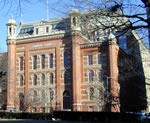Adolf Cluss (1825-1905) : Idealism and Pragmatism in Architecture
"German-American architect Adolf Cluss (1825-1905) came from a Heilbronn, Germany family of master builders. He left Heilbronn as a young man to be a traveling carpenter.
In Brussels, he met Karl Marx and joined the early Communist movement there. He also went to Paris and to Mainz, where he began work in 1846 as an architect, planning the railroad to Ludwigshafen. In the spring of 1848, he became a central figure in the revolutionary movement, as a co-founder and Secretary of the Workers' Council. Soon after, in summer of 1848, he left Germany, and on September 15, 1848 arrived in New York via the immigrant ship "Zürich."
Adolf Cluss worked in the USA first as an engineer - for the Navy, among other employers - then in Washington as an architect, where he worked largely in red brick and red sandstone. He broke off from the Communist movement in 1858.
Beginning in the 1860's, Adolf Cluss worked as an architect in Washington and completed commissions for public buildings - public schools (separate schools for white and black children), museums, office buildings, market halls, and residences. As of 1890, at the end of his career, most of the public buildings in the American capitol could be attributed to Cluss. Of his seventy buildings, seven still stand today, including the Arts and Industries Building of the Smithsonian Institution on the National Mall, the downtown Masonic Temple, the Eastern Market, the Franklin School (for white children), and Sumner School (for black children), and the downtown Baptist Church (Northern progressive).
Exhibitions in Washington, D.C. and in Heilbronn mark the 100th anniversary of his death. Public events in both Washington and Heilbronn focus on Adolf Cluss's life and work.
Source text and Photo credit: http://www.adolf-cluss.org/

Adolf Cluss Franklin Public School for White Children, Washington, D.C. (Presently, a public shelter for homeless [black] men; and proposed to be soon converted to a small luxury "boutique" hotel.) From the top floor of this public building, Alexander Graham Bell first transmitted a wireless telephone message over a thin beam of light.
In Brussels, he met Karl Marx and joined the early Communist movement there. He also went to Paris and to Mainz, where he began work in 1846 as an architect, planning the railroad to Ludwigshafen. In the spring of 1848, he became a central figure in the revolutionary movement, as a co-founder and Secretary of the Workers' Council. Soon after, in summer of 1848, he left Germany, and on September 15, 1848 arrived in New York via the immigrant ship "Zürich."
Adolf Cluss worked in the USA first as an engineer - for the Navy, among other employers - then in Washington as an architect, where he worked largely in red brick and red sandstone. He broke off from the Communist movement in 1858.
Beginning in the 1860's, Adolf Cluss worked as an architect in Washington and completed commissions for public buildings - public schools (separate schools for white and black children), museums, office buildings, market halls, and residences. As of 1890, at the end of his career, most of the public buildings in the American capitol could be attributed to Cluss. Of his seventy buildings, seven still stand today, including the Arts and Industries Building of the Smithsonian Institution on the National Mall, the downtown Masonic Temple, the Eastern Market, the Franklin School (for white children), and Sumner School (for black children), and the downtown Baptist Church (Northern progressive).
Exhibitions in Washington, D.C. and in Heilbronn mark the 100th anniversary of his death. Public events in both Washington and Heilbronn focus on Adolf Cluss's life and work.
Source text and Photo credit: http://www.adolf-cluss.org/

Adolf Cluss Franklin Public School for White Children, Washington, D.C. (Presently, a public shelter for homeless [black] men; and proposed to be soon converted to a small luxury "boutique" hotel.) From the top floor of this public building, Alexander Graham Bell first transmitted a wireless telephone message over a thin beam of light.


0 Comments:
Post a Comment
<< Home